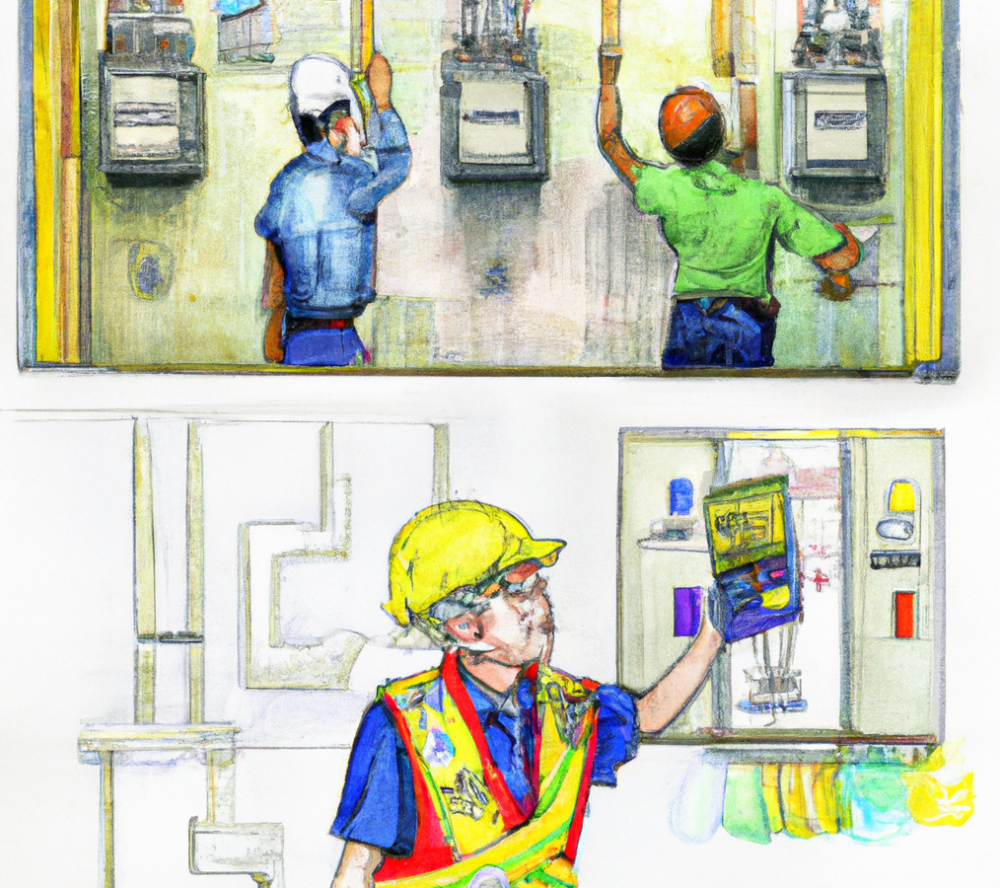In the world of building and construction, understanding and addressing comments from the permit office can sometimes be a daunting task, especially when they involve complex technical terms and code references. This is particularly true for Mechanical, Electrical, and Plumbing (MEP) comments that relate to our everyday comforts, such as air conditioning. In this blog post, we’re going to break down a set of MEP comments related to a recent permit application for a split air conditioning unit.
Before we delve into the comments, it’s essential to understand some of the technical terms and acronyms. Here’s a quick glossary to help:
- ACCU (Air Cooled Condensing Unit): A component of an air conditioning system which condenses a substance from its gaseous to its liquid state, by cooling it.
- FCU (Fan Coil Unit): A device that uses a coil and a fan to heat or cool a room without connecting to ductwork.
- NEC (National Electrical Code): A set of standards for the safe installation of electrical wiring and equipment in the United States.
- GFCI (Ground Fault Circuit Interrupter): A device that shuts off an electric power circuit when it detects that current is flowing along an unintended path, such as through water or a person.
- WP (Weatherproof): Equipment or materials designed to be resistant to weather conditions.
- UPC (Uniform Plumbing Code): A model code developed by the International Association of Plumbing and Mechanical Officials to govern the installation and inspection of plumbing systems.
- Disconnecting Means: A device, or group of devices, or other means by which the conductors of a circuit can be disconnected from their source of supply.
- Branch Circuit: The electrical conductors between the final overcurrent device protecting a circuit and the outlet(s).
- Overcurrent Protection Device: A device such as a circuit breaker or fuse designed to interrupt the electric current if it exceeds a safe level.
- Grounding: A process used to eliminate unwanted voltage or “noise” on electrical circuits or equipment by creating a direct physical connection to the earth.
- Condensate Drain: Part of the HVAC system that allows condensation to drain off from the cooling coils.
- Indirect Waste Pipe: A waste pipe that does not connect directly with the drainage system, but that discharges into the drainage system through an air break or air gap into a trap, fixture, receptor or interceptor.
Now, armed with this understanding, we can look at the comments. The table below simplifies these comments, provides relevant code references, and offers clear, actionable steps to address the concerns raised. Our goal is to help make this technical language more accessible, enabling you to understand and respond to these comments effectively.
Summary of MEP Comments and Corresponding Actions
| Comment | Code Reference | Summary | Suggested Action |
|---|---|---|---|
| Unable to determine code compliance. Provide a mechanical schedule identifying the manufacturer, model number, and complete electrical ratings of all ACCUs and FCUs. In addition, identify the FCUs corresponding to each ACCU. | N/A | The permit office is unable to verify if the provided information aligns with the code requirements. They want a detailed list of all Air Conditioning Condensing Units (ACCUs) and Fan Coil Units (FCUs) with their specific details. | Provide a detailed list of all ACCUs and FCUs with their manufacturers, model numbers, and electrical ratings. Also, specify which FCU corresponds to each ACCU. |
| The symbol list should identify the electrical ratings of all electrical equipment and clearly differentiate between new and existing electrical items. | N/A | The list of symbols used in the plan should show the electrical ratings of all equipment, and it should be clear which items are new and which are existing. | Update the symbol list to include the electrical ratings and clearly mark new and existing items. |
| Provide disconnecting means for each ACCU per NEC Section 440.11 and located per NEC Section 440.14. | NEC 440.11, 440.14 | The National Electrical Code (NEC) requires a way to disconnect each ACCU for safety, and it specifies where the disconnecting means should be located. | Add a disconnecting means for each ACCU and ensure it is located as per NEC Section 440.14. |
| Provide disconnecting means for each FCU per NEC Section 430.102(B). | NEC 430.102(B) | Similar to the ACCUs, each FCU needs a disconnecting means as per the NEC. | Add a disconnecting means for each FCU as per NEC Section 430.102(B). |
| Provide an updated industry-standard panel schedule to include the new air conditioning branch circuits. Clearly differentiate between new and existing circuits in the panel schedule. | N/A | The panel schedule should be updated to include the new air conditioning circuits, and it should be clear which circuits are new and which are existing. | Update the panel schedule to include the new air conditioning circuits and differentiate between new and existing circuits. |
| Provide on the plan calculations to show that the existing feeder circuit of the dwelling is capable of handling the new air conditioning equipment plus the existing dwelling loads. Calculations shall be in accordance with NEC Article 220. | NEC 220 | The plan should show calculations that prove the existing electrical system can handle the additional load from the new air conditioning equipment, as per NEC guidelines. | Provide load calculations following NEC Article 220 to prove the existing“`html system can handle the new air conditioning equipment. |
| Provide GFCI, WP, weather-resistant listed receptacle for the servicing of air conditioning equipment per NEC Sections 210.8(A)(3), 210.63, and 406.9. Note: If the receptacle exists and is intended to serve within the project area, locate the receptacle on drawing and designate it as existing. | NEC 210.8(A)(3), 210.63, 406.9 | The NEC requires a Ground Fault Circuit Interrupter (GFCI), Weatherproof (WP), weather-resistant receptacle for the servicing of the air conditioning equipment. | Provide a GFCI, WP, weather-resistant listed receptacle for the air conditioning equipment. If the receptacle already exists and will serve the project, locate it on the drawing and label it as existing. |
| Provide a branch circuit diagram for the air conditioning equipment. The circuit design shall show all electrical equipment (i.e. overcurrent protection device, disconnect switch, etc.). Provide electrical rating of equipment, wire/conduit identification and sizing, and grounding. Clearly differentiate between new and existing electrical items. | N/A | The plan should include a detailed diagram of the electrical circuit for the air conditioning equipment. It should show all electrical equipment, their ratings, wire/conduit identification and sizing, and grounding. It should also clearly differentiate between new and existing electrical items. | Provide a detailed branch circuit diagram for the air conditioning equipment, including all required information and differentiating between new and existing electrical items. |
| Provide air conditioning condensate drain size. [2018 UPC 814.0] Also clearly indicate termination location. the end of the line shows an arrow (unclear if this is the end or if continues.) Condensate shall not drain over a public way. [2018 UPC 814.3] (Can’t terminate at concrete patio area) | UPC 2018 814.0, 814.3, 814.5 | The Uniform Plumbing Code (UPC) requires the air conditioning condensate drain to be a certain size and made of a certain material. The drain must not end over a public way and can’t terminate at a concrete patio area. The termination location should be clearly indicated. | Specify the size and material of the condensate drain pipe according to UPC 814.3. Make sure the drain does not terminate over a public way or a concrete patio area. Clearly indicate the termination location on the plan. |
If you find the MEP comments and their corresponding actions a bit too technical or complex, or if you don’t have the necessary time or resources to make the changes yourself, you’re not alone. Many individuals and businesses find themselves in a similar situation. The good news is that you can find qualified professionals who specialize in this field to help you. Sites like Upwork offer a platform to connect with experts who can address the comments efficiently and economically.
Sample Statement of Work:
Title: Expert Needed to Address MEP Permit Comments for Split A/C Project
Project Description:
We are looking for a qualified professional with a strong background in mechanical, electrical, and plumbing (MEP) systems, particularly in the area of air conditioning units. The project involves addressing specific MEP comments provided by a permit office for a split A/C system installation.
Scope of Work:
- Review and understand the specific MEP comments and necessary actions related to our project, which are outlined in a blog post (link will be provided upon project initiation).
- Develop a plan to address each comment, keeping in mind that the response must comply with all relevant codes and standards mentioned in the comments.
- Revise the necessary plans or drawings to comply with the comments and clearly mark all revisions.
- Prepare responses to each comment explaining how it has been addressed.
- Submit the revised plans/drawings and responses to us for review.
Required Skills and Experience:
- Strong knowledge of MEP systems, specifically split A/C units.
- Familiarity with National Electrical Code (NEC) and Uniform Plumbing Code (UPC).
- Experience in responding to permit comments and revising plans/drawings.
- Excellent communication skills and attention to detail.
Please provide examples of similar projects you have completed in the past, along with references if available. We look forward to finding the right expert to help us navigate this process effectively and efficiently.
Conclusion
Navigating the complexities of MEP comments for a permit application, like the one for a split A/C system, can be a challenging task, especially when it involves technical jargon and code references. However, by breaking down these comments, providing a comprehensive glossary of terms, and offering actionable steps, we hope to have made this process a bit more accessible.
Remember, it’s not essential to take on all of this yourself. Professionals are available who specialize in addressing these kinds of comments. Using platforms like Upwork, you can find the right expert who can efficiently and economically help you revise your plans or drawings to meet the necessary requirements.
The key is understanding what’s needed and knowing when to seek help. With the right information and the right people, you can navigate your way through the MEP comments and ensure your project is a success. We hope this guide proves useful in your journey, whether you decide to tackle the comments yourself or enlist the help of an expert.
Remember, the goal is to ensure safe, efficient, and code-compliant installations. So, take the time to understand the comments, make the necessary adjustments, and move your project forward with confidence.
 Copyright secured by Digiprove
Copyright secured by Digiprove 



